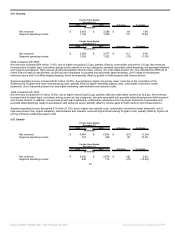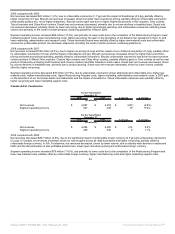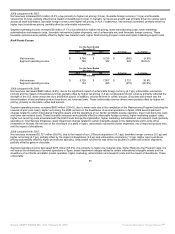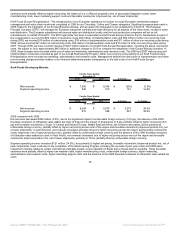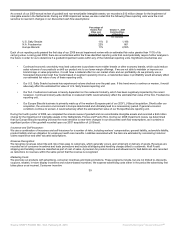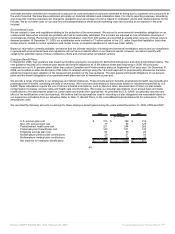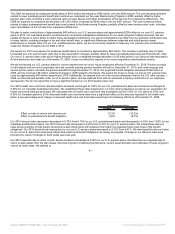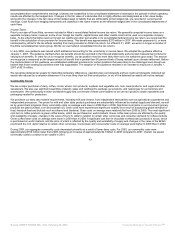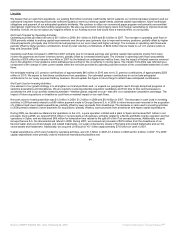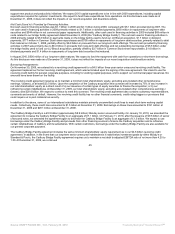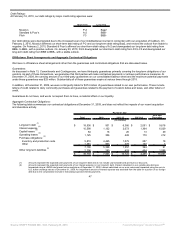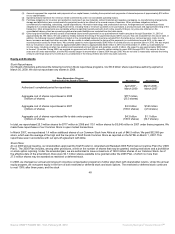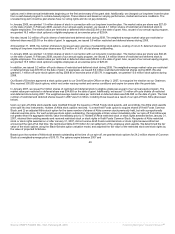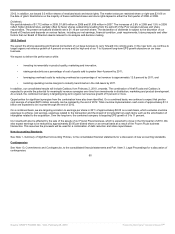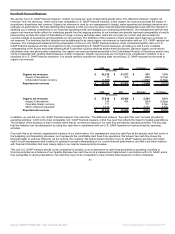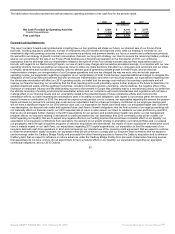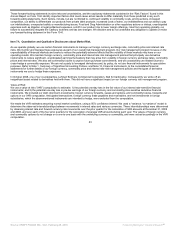Kraft 2009 Annual Report Download - page 46
Download and view the complete annual report
Please find page 46 of the 2009 Kraft annual report below. You can navigate through the pages in the report by either clicking on the pages listed below, or by using the keyword search tool below to find specific information within the annual report.
accumulated other comprehensive earnings / (losses) are reclassified to the consolidated statement of earnings in the periods in which operating
results are affected by the hedged item. Changes in the fair value of a derivative that is highly effective and designated as a fair value hedge,
along with the changes in the fair value of the hedged asset or liability that are attributable to the hedged risk, are recorded in current period
earnings. Cash flows from hedging instruments are classified in the same manner as the affected hedged item in the consolidated statements of
cash flows.
Income Taxes:
Prior to our spin-off from Altria, we were included in Altria’s consolidated federal income tax return. We generally computed income taxes on a
separate company basis; however, some of our foreign tax credits, capital losses and other credits could not be used on a separate company
basis. To the extent that Altria used our foreign tax credits and other tax benefits in its consolidated federal income tax return, we recognized the
benefit in the calculation of our provision for income taxes. This benefit was approximately $270 million in 2007. We made payments to, or were
reimbursed by, Altria for the tax effects resulting from being included in Altria’s tax return. As of March 31, 2007, we were no longer a member of
the Altria consolidated tax return group. We file our own federal consolidated income tax returns.
In July 2006, new guidance was issued which addressed accounting for the uncertainty in income taxes. We adopted the guidance effective
January 1, 2007. The guidance clarified when tax benefits should be recorded in the financial statements and provided measurement criteria for
valuing such benefits. In order for us to recognize benefits, our tax position must be more likely than not to be sustained upon audit. The amount
we recognize is measured as the largest amount of benefit that is greater than 50 percent likely of being realized upon ultimate settlement. Before
the implementation of this guidance, we established additional provisions for certain positions that were likely to be challenged even though we
believe that those existing tax positions were fully supportable. The adoption of this guidance resulted in an increase to equity as of January 1,
2007 of $213 million.
We recognize deferred tax assets for deductible temporary differences, operating loss carryforwards and tax credit carryforwards. Deferred tax
assets are reduced by a valuation allowance if it is more likely than not that some portion, or all, of the deferred tax assets will not be realized.
Commodity Trends
We are a major purchaser of dairy, coffee, cocoa, wheat, corn products, soybean and vegetable oils, nuts, meat products, and sugar and other
sweeteners. We also use significant quantities of plastic, glass and cardboard to package our products, and natural gas for our factories and
warehouses. We continuously monitor worldwide supply and cost trends of these commodities so we can act quickly to obtain ingredients and
packaging needed for production.
We purchase our dairy raw material requirements, including milk and cheese, from independent third parties such as agricultural cooperatives and
independent processors. The prices for milk and other dairy product purchases are substantially influenced by market supply and demand, as well
as by government programs. Dairy commodity costs on average were lower in 2009 than in 2008. Significant cost items in our biscuit and grocery
products are grains (wheat, corn and soybean oil). Grain costs have experienced significant volatility as a result of burgeoning global demand for
food, livestock feed and biofuels such as ethanol and biodiesel. Grain costs on average were relatively flat from 2008 to 2009. The most significant
cost item in coffee products is green coffee beans, which are purchased on world markets. Green coffee bean prices are affected by the quality
and availability of supply, changes in the value of the U.S. dollar in relation to certain other currencies and consumer demand for coffee products.
Green coffee bean costs on average were lower in 2009 than in 2008. A significant cost item in chocolate confectionery products is cocoa, which
is purchased on world markets, and the price of which is affected by the quality and availability of supply and changes in the value of the British
pound and the U.S. dollar relative to certain other currencies. Cocoa bean and cocoa butter costs on average were higher in 2009 than in 2008.
During 2009, our aggregate commodity costs decreased primarily as a result of lower dairy costs. For 2009, our commodity costs were
approximately $150 million lower than 2008, following an increase of approximately $2.0 billion in 2008 compared to 2007. Overall, we expect
commodity costs to continue to be volatile in 2010.
43
Source: KRAFT FOODS INC, 10-K, February 25, 2010 Powered by Morningstar® Document Research℠


